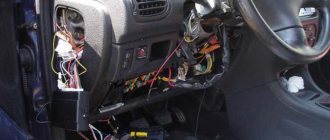An alarm is a necessary measure to protect a car from theft, but an alarm alone is not enough: criminals have learned to turn it off faster than the owner can respond to an alarm. Therefore, drivers are increasingly installing a GPS tracker along with the alarm system - a device that tracks the location of the car, its route and speed.
- How does a GPS tracker work?
- How to choose a GPS tracker
- Functions and purpose of a GPS tracker
- Where are GPS trackers installed?
- How to install a GPS tracker
- How not to buy a fake
- How much does a GPS tracker cost?
Even knowing that a tracker is installed in the car, car thieves will not be able to quickly find and remove it, which means that in order to detect a stolen car, the rightful owner will only have to look at the screen of a computer or smartphone. A special program will show where the satellites “located” the beacon. A GPS beacon can be installed on any type of vehicle, but for it to work as described, it must be correctly selected, installed and connected.
How does a GPS tracker work?
Any tracker model consists of a receiver and transmitter. The receiver is based on the global GPS satellite system. It receives signals from satellites in low-Earth orbit and thus determines the exact coordinates of the object. The GPS system itself is free and can work without the Internet: you don’t need to pay for accessing a couple of dozen American satellites, but cellular communications or GPRS may require payment - these are the communication formats the transmitter uses. The function of this module is to transmit the signal received by the receiver to your computer or smartphone.
The tracker design also includes an antenna and a battery. The antenna can be internal or external, that is, hidden in the device body or located outside. Battery-powered models are called autonomous, but there are also devices that connect to the car's electrical system, or universal models that allow you to choose the type of power. The best option is a stand-alone or universal model. Such a tracker can operate on battery power for years; it is easier to install and more difficult for strangers to detect.
The simplest GPS informant is used by hikers and explorers of wild spaces: it is a simple device with a special chip that receives satellite signals. The device deciphers signals into geographic coordinates, but to determine the location, the tourist additionally needs a map with a navigation grid. Car GPS trackers are more complex and cannot be deciphered using a regular map, so you will need special software that will turn the signals into a route map or speed reading.
What to look for when choosing a tracker
The choice should begin with the device interface, namely with the definition of the service through which interactive tracking will be carried out. In addition, the following should be clarified:
- Activate the device and configure it online. If there is no such option, then you will have to install drivers on your computer and configure the device manually. To do this, you will have to use a USB cable or send complex commands via SMS.
- Online tracking mode.
- Detailed maps (and the ability to support several cartographic sources at once).
- Availability of listening mode.
- Possibility of real-time monitoring through mobile applications.
- Methods of notification. This could be an SMS message, an email or a phone call.
- Ability to view routes by date. This will be possible if the device allows you to store the event history for a long time.
- Easy to view data format. This is especially true for business, since data can be sent in an Excel or 1C table. Thus, reports for the company will be compiled in the most convenient way.
This is interesting: The new Toyota C-HR drove around Tolyatti without camouflage
If you plan to use the tracker for “household” purposes, be sure to ask the seller how accurately the device determines the coordinates. There is a standard among manufacturers according to which the error should not be 2.5 meters. If the device’s characteristics indicate a higher value, then most likely it is a completely “left-handed” device.
Also check the cold and hot start times, that is, the time it takes for the tracker to detect and transmit a signal. For a cold start, this value is calculated from the moment the car engine starts or the device is turned on. Most often it is less than 40 seconds. A hot start is the period from the start of the car’s movement if you stopped for some period. Basically this value is about 5-15 seconds.
The last thing you need to pay attention to is the receiver. For urban conditions, 3D GPS models are considered the best. And also, do not confuse a GPS tracker with a GPS beacon, since these devices are very different.
How to choose a GPS tracker for a car
When choosing an accurate GPS tracker, pay attention to what software it works with and what satellites it accesses. The best option is if the device uses not only the American satellite network, but also GLONASS. Of course, it must be compatible with the operating system that your smartphone, tablet or laptop uses. Although most navigation software developers try to adapt programs to all current operating systems, releasing versions for Windows, Android and iOS, there may be exceptions.
Things to consider when purchasing a tracker:
- Tracking sensitivity. This characteristic determines whether you can track the vehicle in the presence of interference. To achieve good sensitivity, choose models that work on the basis of A-GPS (do not confuse it with the AGPS cellular communication system!). They maintain high accuracy even in the presence of strong interference.
- Memory card. There are GPS trackers on sale with and without built-in memory cards. The memory allows you to save information about the route and location of the car for a long time. But this does not mean that you need its maximum volume. Consider your own conditions and tasks: a large amount of memory is used, as a rule, by corporations that track the movement of their cargo and couriers.
- Temperature conditions. Most tracker models are designed for temperatures down to minus ten. Pay attention to this parameter if operating conditions are harsh and the temperature may drop below the specified mark.
Functions and purpose of a GPS tracker
The basic functionality of a car tracker is to determine exact coordinates, time and speed of movement. This is enough to track transportation or protect against theft, but the basic set of functions can be expanded by coordinating the work of the tracker with security systems.
Additional features of the GPS tracker:
- Fuel consumption control.
- Recording data on temperature in the cabin and body.
- Indication of lock operation.
- Warning about an object leaving the permitted zone, etc.
Each additional feature affects the cost of the equipment, so the greatest demand for advanced functionality is among commercial enterprises. Private car owners use GPS trackers with standard functionality, especially since they play the role of an alarm beacon even without connecting to the on-board power supply, which is necessary to expand the capabilities of the device.
How it works: we look for a car on the map and control the tracker
In a nutshell, about the accuracy of location control using GPS or GLONASS, then any GPS tracker is “like a navigator.” Manufacturers claim support for up to 72 channels of work with satellites and an accuracy of 3-5 meters. But in reality, the location accuracy varies from the promised 3-5 meters to 20-30 meters; Moreover, one time the tracker can find itself using exactly 5-7 satellites, and another time, and with a larger number of satellites, the same tracker is mistaken by 20-30 meters. But here’s the thing: given the dimensions of the car, such a deviation is not critical! This is not a walk, where at a distance of 20-30 meters there are two paths that lead in different directions; This is a car 4-5 meters long, which you can see with your eyes - you would know where to look if something happens.
You can hide from GPS and GLONASS satellites in the deep underground parking lot of a business or shopping center. But then the LBS (Location Based Service) technology – “binding” to base stations of the cellular network will help to approximately determine the location; of course, if there is a separate cellular network signal transmitter in the underground parking lot. The same technology will help in monitoring a person on foot with a tracker who is traveling in the subway underground - he can be “detected” at stations where there is mobile network coverage. Here, a lot depends not only on the network and the number of base stations, but also on the device itself: for example, according to the manufacturer’s information, iBag FOX uses an improved location search function (QuecCell standard), which polls up to 6 base stations from different operators, and not only your SIM card operator.
LBS technology works quickly, but not accurately: the range is 2-3 kilometers even in a large city with a large number of base stations to which you can “link” (Kiev, according to trackers - I’m in Poznyaki, in reality - near Darnitskaya Square). What if there is only one base station for the entire village? It will be possible to find out that a person or car is “somewhere here.” But LBS justifies itself when tracking a person in the subway and when monitoring a car in underground or covered multi-level parking lots - however, only if there is a mobile communications base station there.
Of greater interest are the operating modes of the trackers and how to control them. Thus, we can distinguish two conditional modes of operation of the GPS tracker. The standard mode is “beacon”: it means turning on once a day (you can separately configure more frequent or less frequent turning on), determining the location, transmitting information, and switching to sleep mode. Emergency mode, which is used when searching for a stolen car or missing person - “SOS”: implies frequent contact or even constant work, determining location and transmitting information. Even if the latter mode is not directly provided by the tracker manufacturer, it can be obtained by simply changing the intervals of the operating mode (often or constantly) and sleep mode (minimum or equal to “0”).
It is important that with each contact – even in the “beacon” mode, once a day – the tracker works for at least 5-6 minutes: the search time for satellites during a “cold start” is usually three minutes, but can increase to five. Accordingly, the device needs to be given a reserve of time so that the GPS tracker has time to find satellites, record coordinates, and transmit information to the control server.
All trackers are monitored using SMS commands with code words like “worktime=10” (which means “working time is 10 minutes”) or “GPS?” (which means “determine the coordinates of the location using GPS”). Depending on the model, SMS commands may be indicated only in English or also in Cyrillic. In addition, the commands themselves can be typed either in complex codes or in simple, understandable phrases - for example, the M130 Marker and X-Keeper Invis Duos stand out for the better. In general, SMS communication with a GPS tracker looks like this:
We send
an SMS to the request-command; The GPS marker sends a response - for example, confirmation of the owner’s phone number, a change in IP address, location coordinates via GPS or GLONASS (in this example, Pandora NAV -05 sent coordinates via GLONASS, in general everything is accurate and correct). Just “click” on the text link in the SMS and a map will open with the tracker’s location marked.
Another option is to monitor the location of the tracker on a special website. This can be either a third-party site or the site of a company that produces GPS trackers of this model. To access the site, you must enter the login and password with which the device is linked. And then - it all depends on the capabilities of the site: only tracking, additional functions, the ability to manage, etc.
As a rule, even the “simplest” sites make it possible to change the appearance of the map, view the speed of the tracker (vehicle), observe recorded waypoints, manage geo-fences, control the voltage in the vehicle’s on-board network and the ambient temperature (if such capabilities are supported by GPS -tracker), etc.
“Advanced” sites allow you to do even more. Firstly, they make it possible to send commands to the tracker and control it; thus, there is no need to send SMS commands from the phone - more choice of commands, more convenience, saving money. Secondly, it is possible to display a report in the form of text or table (XLS): date and time, location coordinates, speed, etc. Often, access to advanced functionality requires contacting the device manufacturer and/or concluding a service agreement. But the subscription fee is still small - from 50-60 UAH. per month. And in general, the functionality of a free website will be enough for an ordinary car enthusiast.
iBag FOX tracker and its work with two sites. Option one: gps - trace . com - free, you can see the location of the car, speed, etc. Option two: gps . overseer . ua – the creation of a new object is required, there is a subscription fee; but the tracker can be controlled by commands from the site itself, without SMS - the question is not so much about saving money as about ease of management and more commands
ibag FOX (bookmark) GPS trackers on
from 2,799 UAH
Suggestions: 2
Compare prices
Finally, the last option is a proprietary smartphone application. As a rule, the application offers: displaying a map and the location of an object, controlling the speed of the car, viewing the starting point and finishing point on the route - i.e. We are talking at least about the functionality of a “free” site.
However, apps can often do more! Depending on the application and tracker model, you can: control the GPS beacon (send commands from the application instead of SMS commands); set geo-zones; change the time the tracker is turned on, the frequency of its communication, and the operating time when searching for satellites; view transaction history; combine several tracking objects into one group and monitor them simultaneously; request a report on the movement of an object along recorded waypoints.
Application
X - Keeper as examples of combining simplicity and functionality. On the one hand, there is a page for monitoring the object, where everything is simple, concise, understandable, without unnecessary details. But if you dig deeper, it turns out that you can configure various tracker parameters through the application. Moreover, next to each settings item there is a small pop-up menu that explains the essence of the settings. Great!
Where are GPS trackers installed?
The installation location and type depend on the power supply. Security monitoring systems require connection to the on-board network, so they are mounted under the dashboard. But autonomous devices with their own battery are more flexible in choosing the installation location: they can be mounted behind the radio, next to the glove compartment, or in any other place.
There are no special requirements for the location of autonomous models: they have a dust- and moisture-proof housing, and the only thing you should remember is the maintenance and repair of the GPS tracker. It is advisable to mount the “beacon” in a place where it can be repaired without dismantling. You may need to change settings or recharge the battery, and this will be easier if the GPS tracker is located in an accessible location. On the other hand, you need to maintain a reasonable balance and not attach the equipment in plain sight so that car thieves won’t notice it.
Exterior and internal design
At first glance, all GPS trackers are similar: a small plastic box; depending on the model - several wires, a power button, a signal LED or a couple of diodes. And this is the case when the first glance does not deceive - upon closer inspection it is impossible to find any interesting details. This is because the interesting details are hidden inside.
If we open any GPS tracker or beacon, we will see approximately the same design: there is an antenna for communication with satellites (GPS and GLONASS); there is a slot for a SIM card (and even two slots); there is a processor for processing information. After all, the general functionality of all GPS trackers is also similar: they determine their location using satellites (GPS, GLONASS) and/or mobile network base stations (LBS); transmit location information to a special website using a GPRS channel; receive and process SMS commands from the “control” phone; send SMS replies (confirmation of commands or coordinates of their location).
But in details, all GPS trackers differ from each other. For example, there are models with one or two slots for a SIM card: the rule “the more, the better” is relevant here. Firstly, different operators may have different coverage areas in remote areas, and where the first SIM card does not work, the second one from another operator may work. Secondly, a similar rule is also relevant for LBS technology for determining location.
The power supplies also differ: there are models that were originally intended for installation in a car - they are connected to the on-board network with a voltage of 12-24 V; There are models for autonomous use - they are powered by batteries or a rechargeable battery. The most optimal combination power option: the GPS tracker operates from the vehicle’s on-board power supply while the engine is running; and if there is no voltage in the network, it can be powered by its own batteries or a built-in battery. In this mode, the operating time of the battery pack will noticeably increase.
In alphabetical order - let's start with
the iBag FOX GPS tracker : the most compact among the models presented in the review, the size of a matchbox. Small black plastic case with rounded edges; there is a battery charge indicator; Inside there is a 1,200 mAh battery. On one side there is a power button; on the other there is a charging connector. Nominally – powered by battery; but you can additionally order a “28 V-12 V to 5 V” converter and connect it to the car’s on-board network, ultimately receiving a combined power supply
iTrack RV GPS tracker is designed for permanent installation on a car and, most likely, will require an electrician at a service station for connection. But there are several inputs for additional sensors and one control output (I’ll tell you why later). The design provides a backup battery
The Magnum MT -400 S tracker also offers multiple inputs and outputs; it can be powered from the vehicle's on-board power supply or from its own battery. Installing a SIM card and turning on the device - through the “curtain” on the side
Russian Marker M130 is very compact; can operate on batteries or be powered from the vehicle’s on-board network (operating voltage range – 9-30 V). On one of the side faces there is a connection block, a single control button, and a signal LED. The package can also be supplemented with a “panic button” and a relay blocking the engine fuel pump.
Pandora
NAV -05 stands out for its unusual elongated body, on which there is room for a control button, microphone, and signal LED; Inside the case there is a compartment for batteries, although external power is also possible. And the attention paid to literally every detail left a positive impression: all removable covers have a rubberized seal; body – with “ears” for fastening with a tie. Looking ahead: Pandora NAV -05 will pleasantly surprise you in the future
with Pandora NAV-05 GPS trackers on
from 6,415 UAH
Suggestions: 2
Compare prices
GPS beacon
X - Keeper Invis Duos is very small in size: only slightly larger than iBag FOX , but smaller than the others.
The body is made of high-quality plastic, slightly rubberized on some surfaces. Additional elements include three LEDs and a power slider. Power is not provided from the vehicle's on-board network, only its own batteries. With a set of which, as the manufacturer promises, the device will work for 3-5 years “when going on air” 1-2 times a day. By the way, about the promised operating time of the device: yes, all this is “fortune telling on the coffee grounds”! After all, a GPS tracker is a device that spends energy searching for satellites and GSM/GPRS communication (using GSM, SMS commands are received and sent, there are models with a microphone for remote “wiretapping”; using GPRS, location data is transmitted to the server) . As a result, the operating time from an autonomous power source depends on: the frequency of communication (device settings), ambient temperature (for example, a car spends the night outside in winter), the possibility of combined power supply (from the car’s network and its own battery). On average, if the tracker is turned on once a day in the “beacon” mode - turning on, searching for satellites, registering location, getting in touch, transferring data - a set of batteries will last about one year, or maybe less. In the most economical mode (connecting once every couple of days, searching for a location only using LBS technology), a set of batteries can last for 3-5 years; with the active operating mode – “SOS”, the mode of constant search and transmission of information by the tracker – for a day.
The same applies to the costs of operating a GPS tracker. Nominally, all manufacturers claim that there is no monthly fee - and this is true. But you can’t do without expenses: you need to replenish the balance of the tracker’s SIM card so that it can communicate and transmit data via GPRS to the server and/or for the possibility of SMS replies. Plus the cost of sending SMS from your “control” phone. Although compared to the monthly fees for other similar satellite tracking systems (with operators, call centers, etc.), these costs are meager.
How to install a GPS tracker
To connect the equipment to the on-board system, it is better to invite specialists, but autonomous models are not difficult to install, and this can be done without the help of professionals. Most often, hardware or adhesive tape is chosen for installation. If the surface is plastic, choose a tape that will not damage the material. You can also install the “beacon” on screws or self-tapping screws - the housing usually has holes for them. Depending on the chosen installation location, wiring can help secure the GPS tracker, but then you need to additionally secure the wiring itself.
Wired models are not so easy to install: you need to connect at least four wires to the on-board computer, among which there will be an alarm output wire. This alarm cable is connected according to the principle: the red turn is to the positive terminal, and the black wire is to the negative. If the GPS tracker is part of a general security system, the alarm cable may not be used.
To use the system, it is not enough to install it - you need activation. How to activate the GPS tracker is written in the instructions for it. The most common method: an SMS is sent to the device with the text specified in the instructions. After this, the installation can be considered complete.
How to install and configure
After purchasing the selected beacon, you need to install and configure it. It is possible that you will need to purchase some additional materials for installation. Although, as a rule, everything you need comes right away in the kit, so there is no need to purchase anything additional. But if your choice fell on a model of obvious Chinese production, then be prepared for additional costs.
Before installation, do not forget to insert a SIM card and, if necessary, a battery into the beacon. After all, after installation it will be difficult, and sometimes impossible, to do this. Then you will have to dismantle the device (sometimes this is much more difficult to do than install it) and then, after installing all the parts necessary for operation, reinstall it.
After installation, you need to configure your GPS sensor to work in accordance with your needs and desires. Setting up such a device is very specific for each model and must be done in strict accordance with the instructions for the specific model.
How not to buy a fake
On the market you can find GPS trackers made in Russia, China, the USA, and the European Union. Models from Western European manufacturers are considered the best, but you shouldn’t buy the first device you come across that says it was made in the EU. You can really be confident in the high quality of European electronics. Provided that you find it: the market is flooded with fakes, and at first glance it is difficult to distinguish original products from imitation. Even if you open the case, the fraud will not be obvious: Asian businessmen have learned to imitate even the filling.
A fake GPS tracker is only revealed by its operation: already in the first days of use, you can notice inaccuracies in the readings and errors. The only way to insure yourself against counterfeits is to contact reliable, trusted, certified sellers.
How much does a GPS tracker cost?
The cost depends on the brand, technical properties and functionality. The wider the functionality, the more expensive the equipment. A good imported system costs from 7 thousand rubles and more. But if you are looking for a stand-alone device that does not need to be connected to an on-board computer, focus on a price of around 10 thousand. Autonomous models usually do not have very wide functionality, but they effectively cope with their main task: determining the location of the car. So from the point of view of machine safety, the investment is completely justified.
You can also find budget models costing up to 6 thousand on sale. If you want to save money, carefully read the description and reviews. Budget models may have shortcomings in their operation - for example, small errors in determining coordinates, but at the same time they pick up the signal well, regardless of external conditions, and are not afraid of interference. For many car owners, this is a much greater advantage than the ability to determine the position of an object with centimeter accuracy.
And lastly: the GPS tracker partially duplicates the functions of the on-board computer. It determines the location, allows you to plot routes and navigate the area. But the on-board computer does not cope with the main task of this equipment: ensuring safety. The “beacon” allows you to track a car if it is stolen, and in addition, it can play the role of an alarm, giving the owner an alarm signal that the car has left the parking lot. And for business owners, it even makes it possible to remotely control vehicle parameters, and we’re not just talking about trucks: the equipment successfully works on river and sea vessels, aircraft and motorcycles.
Equipment and functionality
It's important to note that a GPS tracker is often not an off-the-shelf product; It's like buying a smartphone: you're buying features. But whether to use them or not directly depends on the tracker settings. At the same time, a lot depends on the configuration of the device: one device makes it possible to implement additional functions, the only question is the correct connection and settings; and another tracker won’t even give you such a choice.
We've figured out the main function of the tracker: determining your location, transmitting this information, and you can set the frequency of communication. Also, almost all GPS beacons have the function of monitoring a geo-zone (street, district, city, region, country) and sending a signal when going beyond its limits. Often there is a speed control function that works according to a similar algorithm: it sends an alarm signal when a specified threshold is exceeded. Another common feature is the waypoint recording function: the tracker turns on, finds itself (via GPS and/or GLONASS), but there is no GSM network - then the movement data is saved in the device’s memory and will be transferred to the server the next time it successfully communicates via GSM /GPRS network. There are models that can send an SMS signal about a low balance on the tracker’s SIM card account or about an impending battery discharge.
And then the special functions begin. And here the leaders are trackers that require more complex installation, but have additional inputs and outputs.
For example, remember this video – “Fast and Furious Truck Robbery”?
So, there are GPS trackers with an additional input on which you can “hang” a contact-limit of a door - or a passenger car, or the door of a semi-trailer - and the device will give an alarm when you try to open the door: be it robbers on the highway or a criminal a truck driver selling some of his goods in a nearby forest belt. You can also connect a fuel level sensor or a panic button to the additional input; There are models that can monitor the voltage in the vehicle's on-board network. Similarly, various auxiliary equipment can be connected to the tracker output: turning on the DVR or a signal to the immobilizer to block the engine fuel pump. Management - using an SMS message containing a specific code word.
Add to this the ease of working with a location monitoring site, the presence or absence of a smartphone application, clear or complex instructions, extensive or simple equipment - and each GPS tracker creates its own picture and gives its own impressions. Good and not so good.
iBag FOX tracker comes with only a mains charger, a USB charging cable, and a small instruction manual in tightly font. As a result, initially it is difficult to understand the device. But the Ukrainian support service helps, where they are ready to explain point by point all the capabilities of the tracker, of which there are many. As a result: the instructions are unsuccessful; support service - credit! And in general, iBag FOX is developed and manufactured by a Ukrainian company, which gives many additional “advantages”: remote software update; the ability to additionally order a mains power supply, a panic button, a fuel pump blocking relay, an enlarged battery...
The
iTrack RV 101 offers multiple additional inputs and one controlled output. The kit includes a connection block with a fuse. The manufacturing company is from Ukraine, office in Dnieper. Therefore, we expect reliable service support, the ability to order additional equipment and constant software updates...
... the same as for the Ukrainian
Magnum MT -400 S : service support, software update, smartphone application. Plus there are nice additional functions: voltage control of the vehicle’s on-board network, temperature control, two inputs and two outputs. The instructions are disappointing - they simply print out the functions on an A4 sheet. Although such a complex and multifunctional device will obviously require installation by a professional and contacting support for initial setup
The M130 Marker is supplied according to the principle of “everything you need and nothing extra”: in addition to the tracker itself, there are only connection wires and adhesive tape for fastening.
However, the M130 Marker is good in details: the instructions are detailed and thorough; The kit includes an activation card, where the most popular SMS commands are written on the reverse side.
Everything is clearly aimed at the “private” car enthusiast and the ease of use of the device GPS Marker M130 GPS trackers on
from 3,551 UAH
Suggestions: 3
Compare prices
And again
Pandora NAV -05 pleases! This time - as a kit: power cord, fasteners, zip ties. And most importantly, the kit includes a blocking relay RR -102 with a pair of “tags”. As a result, by choosing Pandora NAV -05, you buy not only the ability to passively track your car in case of theft, but also the opportunity to prevent theft at all - through the implementation of the anti-theft function. This is already the level of Magnum MT -400 S and iTrack RV 101, where you can implement engine blocking via SMS command; the Pandora NAV kit already has everything. Although in the latter case, the Pandora NAV -05 tracker and the RR -102 relay will also require complex installation, integration into the vehicle’s electrical network, the services of a professional electrician-installer, etc.
X - Keeper
Invis Duos comes in a miniature box, where, in addition to the “beacon” itself, there was only room for adhesive tape and a mini-card with frequent SMS commands. Is simplicity the key to convenience? Possible: X - Keeper Invis Duos managed to connect and configure the fastest, literally in 5-10 minutes










